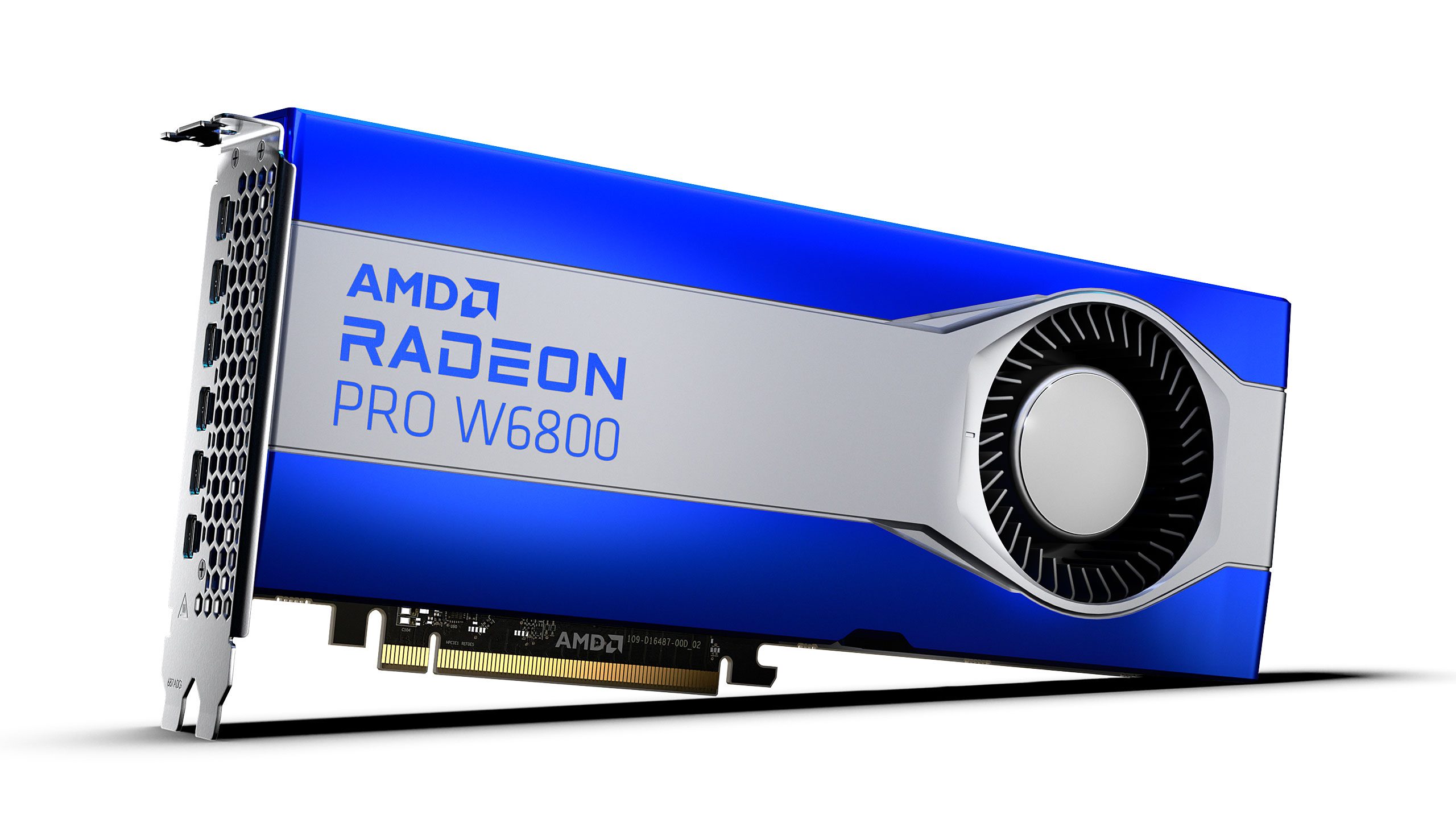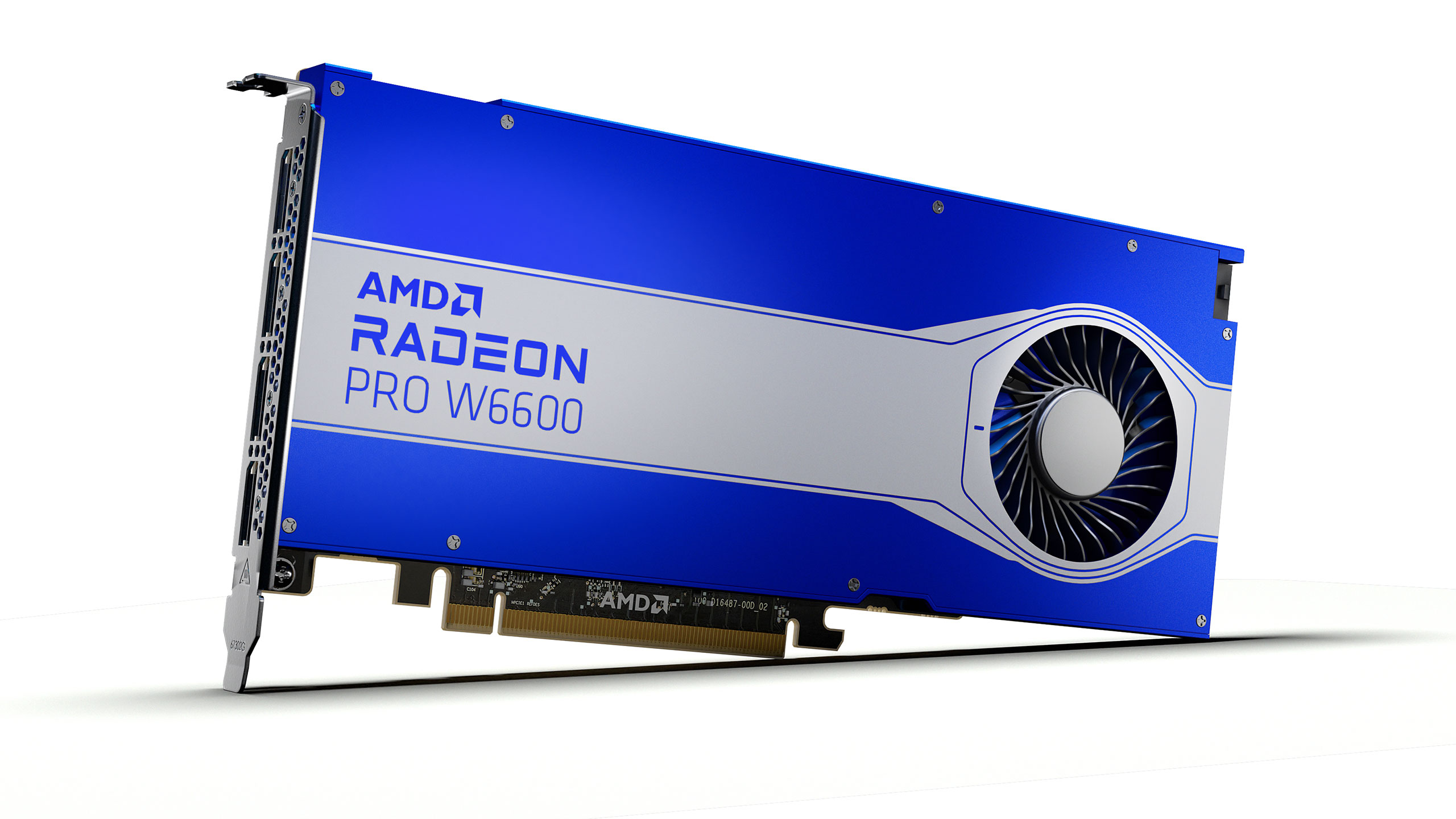AMD Radeon Pro W6800, W6600 and W6600M: RDNA2 Goes Pro
Big Navi comes to AMD's professional line
AMD has officially launched its latest round of professional graphics cards, the Radeon Pro W6800, Radeon Pro W6600, and for laptop users, the Radeon Pro W6600M. Like many of the best graphics cards, these new GPUs leverage AMD's latest RDNA2 architecture, aka Big Navi, which means they bring ray tracing hardware to the lineup, along with the large Infinity Cache. The W6800 also packs 32GB of high-speed GDDR6 memory, which can greatly benefit certain professional workloads.




Starting with the top model, the Radeon Pro W6800 has specs that are very similar to the Radeon RX 6800, just with double the VRAM and with a different card design and drivers. It uses the Navi 21 GPU, but with 60 Compute Units and 3840 GPU cores enabled. It delivers up to 17.83 TFLOPS of FP32 performance and 35.66 TFLOPS of FP16 performance, equating to a boost clock of around 2320 MHz. Like the RX 6800, it also had a 250W TDP, 16Gbps GDDR6 memory and it supports PCIe Gen4.
On the other hand, the actual card design is completely different from the consumer RX 6000-series parts. Like most previous Radeon Pro designs, the Radeon Pro W6800 features a blower cooler, which tends to be preferable to open-air coolers for workstation use as it better supports the use of multiple cards. AMD also equips the W6800 with six mini-DisplayPort outputs, all supporting DisplayPort 1.4 with DSC. Six of the ports can handle up to 5120x2880 resolutions, and two of the ports can do up to 7680x4320 (presumably that's with DSC, Display Stream Compression).
AMD provided testimonials and some benchmarks showing how the Radeon Pro W6800 compares to other professional cards. The biggest point in AMD's favor will likely be the price, with the W6800 officially selling for $2,250. AMD compares it with the Nvidia RTX A6000, which costs over twice as much ($4,649), except AMD's benchmarks then go back to the RTX 5000, a previous generation and obviously slower competitor — #GrainsOfSalt. Depending on the various benchmarks, AMD also shows significant gains over its previous generation Radeon Pro WX 9100 and W5700.





The Radeon Pro W6600 takes a big step down in performance, and arguably the most interesting aspect is that it uses AMD's Navi 23 GPU. Also, it has a suggested price of $649. We still haven't seen Navi 23 in any desktop GPUs, though it's expected to eventually show up in the RX 6600 XT and RX 6600. This is the first time we've seen official specs for anything using Navi 23 with 11.06 billion transistors. Also, as previously rumored, Navi 23 comes with 32MB of Infinity Cache. That's a big step down from Navi 22's 96MB and Navi 21's 128MB, but of course, it was necessary to hit the desired chip size and cost parameters.
AMD doesn't give the size or maximum core counts, but the W6600 does include 28 CUs and 1792 GPU cores. It has peak performance of 10.4 TFLOPS FP32 and 20.8 TFLOPS FP16, which works out to a boost clock of around 2900 MHz. It looks like Navi 23 will clock even higher than Navi 22, if that's correct. Perhaps even more impressive is that the W6600 only has a 100W TDP. Other specs include 8GB of GDDR6 memory, clocked at 14Gbps. It's a single-slot blower design, with four full-size DisplayPort outputs — again, all 1.4 with DSC, though only one can handle 8K resolutions with the other three maxing out at 5K.

The Radeon Pro W6600M has nearly identical specs to the W6600, with the only difference being the TDP ranges from 65–95W. All the other features are the same, and actual boost clocks and display connections will be up to the laptop manufacturers. AMD didn't provide any specific benchmarks of the W6600M, likely because actual laptops using the GPU aren't yet available for testing.
Get Tom's Hardware's best news and in-depth reviews, straight to your inbox.
Overall, AMD claims performance is "up to 79 percent faster" than its previous generation hardware. It can be even more than that in some cases (e.g., anything that uses the ray tracing hardware), but 79% will serve as a reasonable estimate. AMD also shared some performance data with and without the Infinity Cache enabled on the W6800, showing gains of up to 10%, though again, that will vary greatly across workloads.
These Radeon Pro W6800 is available now, with the W6600 slated for availability in Q3 2021. The W6600M should show up first in the HP ZBook G8 mobile workstation in July. Like other professional cards, they come with drivers that include a variety of ISV optimizations.

Jarred Walton is a senior editor at Tom's Hardware focusing on everything GPU. He has been working as a tech journalist since 2004, writing for AnandTech, Maximum PC, and PC Gamer. From the first S3 Virge '3D decelerators' to today's GPUs, Jarred keeps up with all the latest graphics trends and is the one to ask about game performance.
-
-Fran- Hm... If this thing is within strike distance of the over-inflated 6900XT price, then it may not be such a bad purchase all things considered... That 32GB buffer and fully usable FP's are quite a nice thing to have, even if your primary goal is gaming.Reply
What strange times!
Regards. -
Trident1983 just hardware consolidation hard at work to kill e-waste as you only need one type of cpu ssd hdd mobo and gpu soon for gaming and workstation needs lasting for a decade (and for mining crypto too).Reply